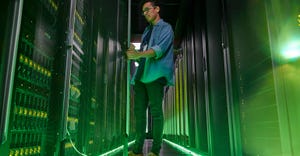The Enduring Attraction of Hong Kong
Political tensions and land shortages can’t stop data center growth in Hong Kong, says Raymond Tong, CEO of SUNeVision, the city’s largest data center operator.

Hong Kong is a remarkable city. For much of its history, it served as the gateway between the East and the West. Colonized by the British in 1841, it welcomed European ships and enabled them to trade with the rest of Asia.
In the digital age, the same city is quickly emerging as a key data center location. It leverages the same historic connections that made it into a global financial hub, with high-capacity fiber cables linking it to the Chinese mainland, and the bustling economies of Japan, Korea, Singapore, Malaysia, Thailand, and the Philippines.
However, building and operating data centers in this region comes with a unique set of challenges: a shortage of land suitable for construction, the perceived limitations imposed by Hong Kong’s new National Security Law, and a complex regulatory regime that stems from China’s "one country, two systems" principle.
To find out more about the regional infrastructure landscape, Data Center Knowledge sat down with Raymond Tong, CEO of SUNeVision, Hong Kong’s largest data center operator.
“There are 14 intra-Asian subsea cables, and out of those, 11 actually land in Hong Kong, because of the geographically central location,” Tong told DCK. “Take away the geopolitical tensions and the trade war, just look at technological and geographical [factors], Hong Kong is a natural hub.”
Geography and destiny
SUNeVision was listed in Hong Kong in 2000 as a data center venture of Sun Hung Kai Properties, the region’s largest property developer. Today, it operates five carrier-neutral facilities across the city, totaling 70MW of power capacity and around 1.4 million square feet of space.
SUNeVision is currently building another three data centers, as it looks to double the space under management – including the 10MW Fanling facility reserved for a single, unnamed hyperscaler, and MEGA IDC, the largest data center in Hong Kong as measured by power capacity.
Out of the 11 aforementioned subsea cables connecting Hong Kong to the rest of the world, nine land in SUNeVision data centers. The benefits of this are so attractive that the company has started building cable landing stations in advance, looking to capitalize on upcoming network projects.
One of the main problems facing businesses that wish to operate digital infrastructure in Hong Kong is construction takes a very long time. In some markets in the US, Europe, and even mainland China, a data center can be delivered in six to nine months. In Hong Kong, this process normally takes four to five years, Tong said – and that’s a long time to wait for a return on an investment. The company’s fastest project, MEGA Plus, took 3.5 years from start to finish.
Something as simple as getting a license to dig up a road to install additional electricity or network cables can be a challenge, just because of the density of the city’s traffic. The power grid is regulated by the government, and applying for a license can take “a couple of years,” Tong said.
Another issue facing local data center developers is the scarcity of land: Hong Kong is suffering from a housing crisis, and was rated as the world's most expensive real estate market by CBRE in 2020 – way ahead of New York and Los Angeles.
One solution to this is building up – and that’s exactly what data center firms have been doing, not just in Hong Kong, but other dense urban environments, like Singapore and Munich.
“The challenge is indeed how to build up high rise data centers. For example, our MEGA-i is a 33-floor building, all 100% data center,” Tong said. “With Hong Kong, the scarcity of land is real, and the price is not cheap. We need to ensure that we optimize every inch of gross floor area.”
Of course, another way to add more servers in a limited space to increase their power density – and data centers in Hong Kong have been doing this too. “It is in our interest to pull in as much power as possible to the limited GFA [gross floor area] and then allow the customer to ramp up their server rack based on 5kW per rack, or 10kW per rack, or even 15kW – the higher the better for us, because we can charge them accordingly,” Tong said.
Like other large colocation providers – most notably Equinix – SUNeVision has started to promote interconnection with its existing customers as one of the benefits of housing servers in its facilities. Tong said the company supports around 15,000 interconnections – about 40% more than what’s available in local Equinix data centers.
“The Chinese cloud gateways, and the US cloud gateways all reside with us for peering and connectivity with one another,” he added.
Tong makes no secret of how the company makes its money: “Hong Kong is a hub and ‘hot’ data is something that the end customer willing to pay for to the cloud [provider], and the cloud [provider] is willing to pay us.
“In Hong Kong, there’s not a lot of high quality supply, but the demand is there, and keeps on growing. As a result, we are able to charge a reasonable price based on our high quality portfolio to enjoy a good financial return.”
A good financial return, in this case, means HK$996 million in revenue in the first half of 2022, with a net profit margin of 41%.
As for the impact of Hong Kong’s controversial National Security Law, which was predicted to cause an exodus of American and European businesses from the city, Tong said it had failed to make an impact on customer uptake, or the company's bottom line.
“The numbers speak for themselves,” he said. “The three year CAGR is still at 11%. In the 12 month period after the National Security Law was announced in Hong Kong, we reached a historical peak again. From a data center point of view, revenue actually increased 14% year-on-year in that particular year. We had more customers going in than coming out.
“Those customers see Hong Kong as a place to do business. I think this is really key. As long as cloud adoption is rising, a lot of enterprises are moving things to the cloud, they will need to procure more data center space. It is as simple as that.”
He also made a prediction about what the Chinese cloud vendors will do next: “The low-hanging fruit, the easy, high-growth markets in China have reached a certain point, and [cloud vendors] need to come outside of China to follow the One Belt One Road, go to Southeast Asia, other parts of Asia, to capture another wave of growth. And Hong Kong is the first stop that they are very comfortable with.”
Read more about:
Asia-PacificAbout the Author
You May Also Like









